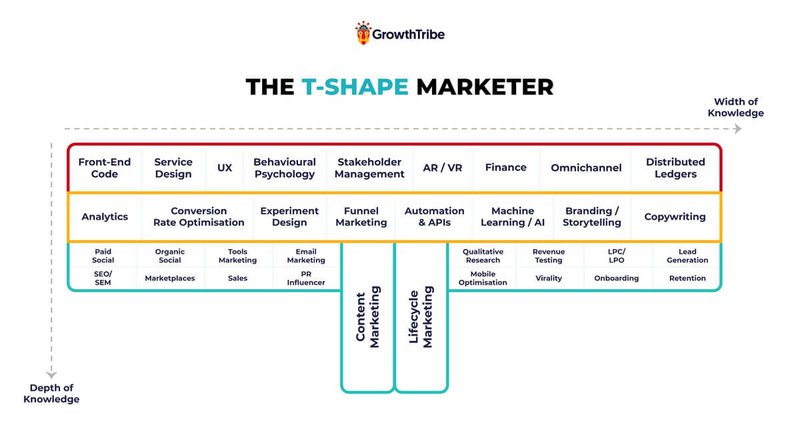What is Growth Marketing? And Why It’s Essential for 2026 [+Examples]
Learn about what growth marketing is, why it's important, how it's different from traditional marketing, growth KPIs and examples of growth campaigns.
Updated November 7, 2024
![What is Growth Marketing? And Why It’s Essential for {year} [+Examples] main image](https://entail.mayple.com/en-assets/mayple/63ac9f3c09eedbfaa4007ac1_mariogoghgMZfweN0hyQunsplash1_fd135cad83ad50f50ecd4b474d7bde85_2000-1699518527447.jpg)
Growth hackers get a bad rap, especially on LinkedIn. And while it's true that there are some charlatans out there, just like with SEO we've learned over the years to love and accept our fellow search geeks for the incredible value they bring.
The same goes for growth marketers. This new breed of marketer came as a response to the feeling that marketing was too mushy. There wasn't enough emphasis on data-driven analysis and experimentation, and on the most important metric - revenue.
So in this post, we break down what growth marketing is, how it differs from traditional marketing, and what you need to look for when hiring a growth marketer.
What is growth marketing?
Growth marketing is a strategic and data-driven approach to marketing that focuses on identifying and leveraging the most effective marketing channels and tactics to drive sustainable growth for a business.
Unlike traditional marketing, which often relies on broad, one-size-fits-all campaigns, growth marketing is focused on continuously testing, experimenting, and iterating to find the most effective ways to grow a business.
What is a growth marketer?
You’ve probably heard of the idea of the T-Shaped Marketer. That’s where a marketer knows the basics about a lot of different topics in marketing (UX, analytics, social, marketing automation, copywriting, etc) and has in-depth knowledge of one or two specific acquisition channels (like organic SEO or paid ads).
Here’s an illustration of what that looks like:
That’s a classic example of a growth marketer. They are a cross between a generalist and a subject-matter expert on a few specific acquisition channels.
Difference between growth marketing and traditional marketing
One of the key differences between growth marketing and traditional marketing is the focus on data and experimentation. While traditional digital marketing is often based on gut instincts and broad assumptions, growth marketing is focused on using data and experimentation to make informed decisions about how to grow a business.
This means that growth marketers are always looking for ways to improve and optimize their marketing efforts, and are willing to try new things and take calculated risks in order to drive growth.
Another key difference is the focus on quick wins and small, incremental improvements. While traditional marketing often focuses on long-term, complex growth strategies, growth marketing is focused on finding the quickest and easiest way to grow.
By focusing on small, achievable goals, businesses can build momentum and drive sustainable growth over time.
Here’s another term that gets thrown around a lot - growth hacking.
Growth marketing vs growth hacking
Growth marketing is often confused with growth hacking, but there are some key differences between the two. Growth hacking is a more tactical, experimental approach to growth that is focused on using creative and outside-the-box techniques to drive rapid growth.
Growth marketing, on the other hand, is a more strategic and data-driven approach that is focused on using data and experimentation to identify the most effective marketing channels and tactics.
So when DropBox launched its incredible referral program that helped them grow to 33.9M users and a $10 billion valuation - that was a brilliant growth hack.
Where did growth marketing come from?
The term growth hacking or growth marketing was coined by Sean Ellis in 2010, to describe how agile companies like Amazon and Airbnb approached growth.
It came out of the need startup world, where companies often have limited resources and need to be creative and scrappy in order to grow. Over time, growth marketing has evolved into a more formalized discipline, with its own tools, techniques, and best practices.
Core components of a growth marketing strategy
So now that you know what growth marketing is, let’s talk about its core components - A/B testing, cross-channel marketing, a focus on the customer lifecycle, and the user experience.
A/B testing
One of the core components of a growth marketing strategy is A/B testing. This is the practice of testing different versions of a marketing message or tactic to see which one performs better. By conducting A/B tests, businesses can quickly and easily identify the most effective approaches and can make data-driven decisions about how to optimize their marketing efforts.
Pro tip: check out our list of the top A/B testing experts for your next project.
Cross-channel marketing
Another key component of growth marketing is cross-channel marketing. This is the practice of using multiple marketing channels, such as email, social media, and paid advertising, to reach customers and drive growth. By using an omnichannel marketing approach, businesses can reach a broader audience and maximize the effectiveness of their marketing efforts.
Customer lifecycle
Growth marketing relies on a rigorous focus on the customer lifecycle. This means looking at the different stages a customer goes through, from the first time they become aware of the business to the point where they become a loyal customer.
By understanding the customer lifecycle, businesses can create marketing campaigns that are tailored to the needs and interests of customers at each stage.
Responsiveness and flexibility
In order to be successful with growth marketing, businesses need to be responsive and flexible in their approach. This means being open to trying new things and being willing to adjust and adapt to new customer needs and market trends based on the data and feedback that they receive.
Customer feedback
Another important aspect of growth marketing is the use of customer feedback. By regularly collecting and analyzing feedback from customers, businesses can gain valuable insights into what is working and what is not, and can use this to improve messaging, targeting, and positioning.
User experience
One of the key factors in driving sustainable growth for your business or product is to perfect the user experience. This means creating an enjoyable and seamless experience for your customers or users, from the moment they first interact with your brand to the moment they make a purchase.
Start by understanding the needs and expectations of your target audience. This means conducting user research and gathering feedback from customers to identify common pain points and areas for improvement. You can then use this information to design a user experience that is tailored to the needs of your audience and meets their expectations.
This can include things like:
- Optimizing your website for mobile devices
- Making sure that your checkout process is quick and easy
- Providing clear and helpful customer support.
Finally, it's important to regularly test and optimize your user experience to make sure that it is meeting the needs of your audience. This can include conducting user testing, analyzing user behavior data, and using marketing analytics tools to see which changes have the biggest impact on user engagement and satisfaction.
Now that you know about the core components of growth strategy, let’s talk about the different types of growth campaigns you could set up.
Examples of growth marketing campaigns
Here are the main growth marketing campaigns that professional growth marketers use to scale businesses.
Top of the funnel engagement
This type of campaign is focused on attracting potential customers to your business and getting them interested in your products or services. TOFU campaigns are used to increase brand awareness and generate leads for your business. This can be done through various tactics such as social media ads, content marketing, or search engine optimization (SEO).
Onboarding
Once a potential customer has shown interest in your business, the next step is to onboard them and get them to make their first purchase. This can be done through personalized emails or messages that introduce the customer to your business, explain the benefits of your products or services, and provide them with special offers or discounts to incentivize their first purchase.
Referral programs
Referral programs are a great way to not only retain existing customers but also attract new ones. By offering incentives such as discounts or rewards to customers who refer their friends or family to your business, you can encourage word-of-mouth marketing and create a network of loyal customers.
Loyalty
Loyalty programs are another effective way to retain customers and drive repeat business. By offering exclusive benefits or rewards to loyal customers, you can incentivize them to continue doing business with you and encourage them to refer others to your business.
Well, all that sounds good, but how do I find a growth marketer to execute these campaigns? First, you need to know the type of qualities and skills to look for.
Qualities of successful growth marketers
In order to be successful with growth marketing, businesses need to have the right qualities and skills on their team. Growth marketers should be data-driven, creative, and product-focused.
They should have a strong understanding of the business and its products and should be able to think outside the box and come up with creative solutions to drive meaningful growth.
Let’s break down each skill in detail.
Data-driven
Successful growth marketers are constantly seeking out data to inform their decisions and better focus their efforts. They regularly track key metrics, analyze data from experiments, and use marketing tools to optimize their campaigns.
Creative
Growth marketing is all about finding new and innovative ways to reach and engage customers. Successful growth marketers are constantly coming up with creative ideas for campaigns, and are always on the lookout for new channels and tactics to try. They are open-minded and willing to experiment and are not afraid to try new things and take calculated risks.
Product-focused
Successful growth marketers are passionate about the product or service they are promoting. They understand the value proposition and are able to clearly communicate it to potential customers. They also have a deep understanding of the product and its target audience and are able to use this knowledge to craft effective marketing messages and campaigns.
Technical skills
In addition to these core qualities, growth marketers should also have strong technical skills. This can include expertise in areas such as data analysis, coding, or technical SEO. These skills can help growth marketers quickly and easily test and optimize their marketing efforts and give them a competitive edge.
Speed
Another important quality of successful growth marketers is speed. In the fast-paced world of growth marketing, it is important to be able to move quickly and make decisions on the fly. Growth marketers should be able to act quickly and decisively and should be able to adjust and adapt as needed based on the data and feedback that they receive.
Types of growth marketing goals & KPIs
There are many different types of growth marketing goals and KPIs that businesses can focus on. Some common goals and KPIs include organic traffic, paid traffic, referral traffic, and on-site metrics.
Organic traffic
Organic traffic is one of the main acquisition channels for any brand and its metrics include the amount of traffic, pageviews, visit duration, conversion rates from organic visitors, and sales.
Paid traffic
Here’s the second most important acquisition channel and it has even more metrics marketers track. You can track the traffic from your paid campaigns, clicks, click-through rate (CTR), ROAS, leads, and sales.
Referral traffic
Another key KPI for growth marketers is referral traffic, which measures the number of site visitors who are referred by another site or source. This can be a powerful driver of growth, as people are more likely to trust and engage with your brand if it has been recommended to them by someone they know and trust.
On-site metrics
On-site metrics are also important for growth marketers to track. This can include things like time on site, bounce rate, and conversion rate. By tracking these metrics, you can gain insight into how well your site is performing and where there may be opportunities for improvement.
Growth marketing best practices
So we’ve talked about the different metrics and the different campaigns you could set up to leverage your growth, here are a few best practices you can use to improve your chances of success.
Stay current with the trends
The world of marketing is constantly changing, and it's important to stay up-to-date with the latest trends and best practices. This means regularly reading industry publications and attending conferences and workshops to learn from others in the field. By staying current, you can ensure that you are using the most effective strategies and tactics to drive growth.
Have a narrow focus
It's tempting to try to do too much at once, but it's often more effective to focus on a few key areas and do them well. This means identifying the most important growth channels and tactics for your business and focusing your efforts on those areas.
By having a narrow focus, your growth marketing team can make the most of your resources and achieve the best results.
Use social proof
Social proof is a powerful tool that can help build trust and credibility with your audience. This can include things like customer reviews, testimonials, and social media mentions, which can all help to show that others have had positive experiences with your product or service.
By using social proof, you can increase the likelihood that potential customers will engage with your brand.
Think creatively
Growth marketing is all about finding new and innovative ways to reach and engage customers. Successful growth marketers are constantly coming up with creative ideas for campaigns, and are always on the lookout for new channels and tactics to try. They are open-minded and willing to experiment and are not afraid to take calculated risks.
Focus on engagement and retention
Acquiring new customers is important, but it's equally important to focus on engagement and customer retention. This means creating engaging and valuable content and experiences that keep customers coming back.
Unlock the power of growth marketing
Excited to scale your business and finally get into the nitty gritty of growth marketing but don’t have the resources? We have a community of 600+ vetted growth marketing agencies and experts that can help you get to the next level. Get started today.
FAQs
What does growth marketing actually mean?
Simply put, growth marketing is the practice of using data and experimentation to identify the marketing channels and tactics that are most effective for driving growth for a particular business. This means constantly testing different approaches, measuring the results, and making adjustments to maximize the return on investment.
What are the benefits of growth marketing?
Growth marketing helps brands grow their customer base through data-driven and highly creative campaigns. It can help increase customer acquisition / sales, improve customer retention, improve the customer experience, and create highly-converting digital advertising campaigns.
Why is growth marketing important?
The purpose of growth marketing is to ultimately growth the business. It involves bringing new customer and improving user acquisition, as well as maximizing the value of existing customers. It can help brands optimize conversion at various parts of the marketing funnel.
What skills do you need for growth marketing?
The most important skills you need to see success in growth marketing are:
- Data analytics
- Digital marketing knowledge
- Optimization
- Basic graphic design
- Experimentation
- experience with advertising channels
What is B2B growth marketing?
B2B growth marketing is an approach to marketing that focuses on generating leads and growing a B2B business. Strategies for growth marketing include digital advertising, content, organic search, email marketing, social media marketing, and various online marketing tactics.
What are some growth marketing examples?
Growth marketing encompasses a number of strategies and channels, here are a few high-level tactics that a modern growth marketer would use:
- Product-led growth
- Improve product development through user research
- Leverage YouTube ads for the initial stages of the funnel
- Build an online community around your product
- Create free tools and templates as lead magnets
- Launch a referral program
- Partner with other orgs in your niche






